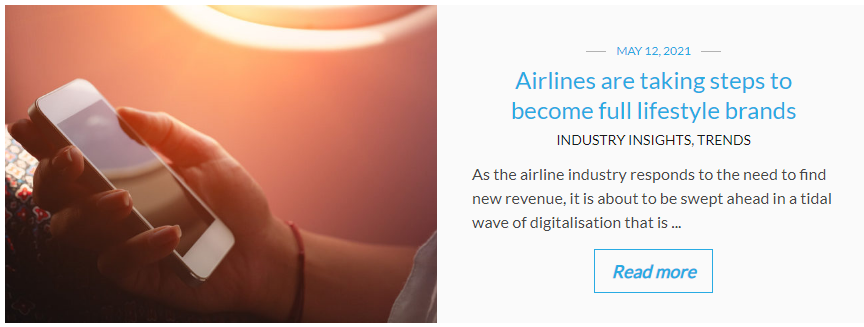The Press Box
In the News: “Airlines are taking steps to become full lifestyle brands” – WTCE
Gillian Jenner explores how ‘in-flight’ is no longer enough for airlines in a post-pandemic world
For her article “Airlines are taking steps to become full lifestyle brands,” on the World Travel Catering & Onboard Services EXPO content hub, Editorial Director Gillian Jenner spoke to several industry players, including Bluebox, to address new opportunities for airline services arising from the pandemic.
A conclusion one can draw from the piece is that, thanks the convergence of two pandemic-driven trends – the drive for ancillary revenue and cabin digitalisation – the service long-known as in-flight entertainment (IFE) has outgrown its own moniker, for the service is no longer just for entertainment, nor is it just ‘in-flight’.
Jenner cites Valour Consultancy’s recent research addressing the market opportunity for wireless IFE (W-IFE) in particular as an enabler in the post-pandemic age calling it the “foundation for airlines to exit the stone age, radically transform their operations and exploit much-needed new ancillary revenue opportunities”.
Noting that Bluebox has teamed up with both Retail inMotion and dnata Catering to sell meals and other products via Bluebox’s W-IFE solutions, Jenner quotes Bluebox CEO Kevin Clark, who commented on the shift in motivation for deploying W-IFE since the pandemic hit:
“It’s probably one of the most striking market observations coming out of the pandemic actually – the shift from the service enhancement proposition of offering W-IFE onboard to IFE being seen and deployed as a revenue-generator.”
Though full connectivity would offer even greater potential for service integration, investments are expected to be delayed due to financial constraints post-pandemic. In the article, Clark highlights the value of captive W-IFE systems in advance of and in support of the business case for full connectivity.
Not only could airlines deploy W-IFE for its immediate revenue generating potential, but also as a brand- and loyalty-building service that helps airlines learn about passenger preferences and digital behaviours. And, because connectivity could distract the passenger away from the airline’s own digital in-flight services, Clark emphasised that developing and learning from a captive W-IFE system could help airlines ensure their service “is ‘sticky’ – keeping passengers coming back for the benefits they gain from engaging with the service.”
Beyond the in-flight benefits of W-IFE, Jenner also explored the potential of linkages to on-the-ground services, quoting Clark again: “Passenger preferences and behaviours will generate considerable data, which will offer insight not only to anticipate products to have available on board, but also open up opportunities for retail partnerships on the ground, which is turn can offer greater revenue generation opportunities for the airline.”
Questioning why an airline would stop at offering retailing services before and after a passenger journey, Jenner wraps up the piece suggesting airlines are in a position to offer “any service, at any time” or as she calls it, “passenger-engagement-as-a-service”. In a sector rife with jargon “PEaaS” may not exactly resolve the acronym issue any better than “IFE” reflects what that really is, it’s a forward-looking concept for sure. And after the year our industry has just endured, looking forward is what we’re all eagerly doing.
Click here or on the image below to read the full article on the WTCE’s content hub.

